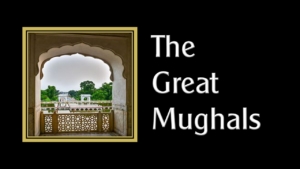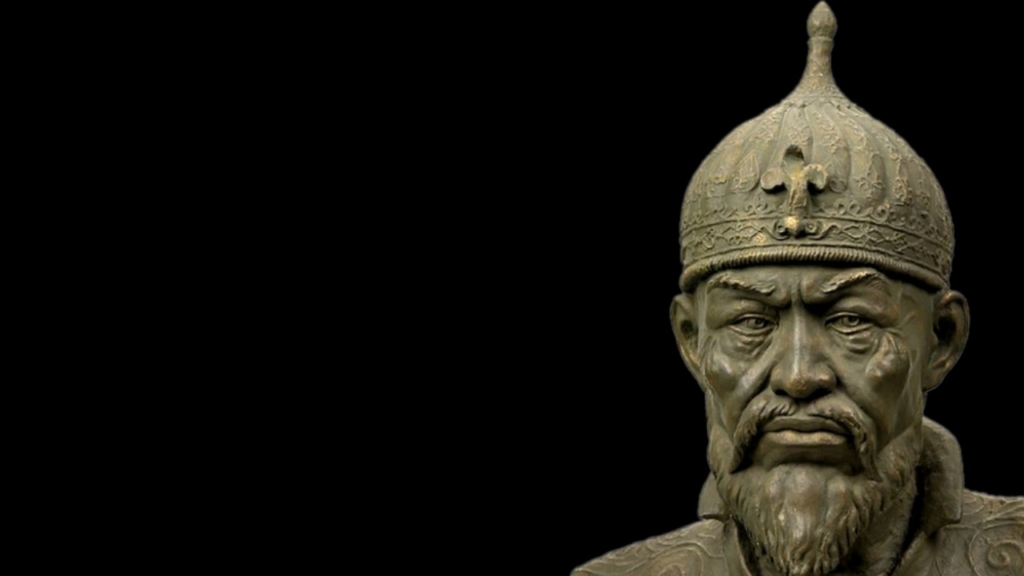This article was published in Dawn, The Review, November 9-15, 2000. I stand corrected about my statement: ‘There is a less reliable tradition that in Damascus, Taimur held discourse with the famous historian and sociologist Ibn-i-Khaldun.’ In fact, it is the report of the meeting between Taimur and the poet Hafiz that has been questioned by historians and not of his meeting with Ibn-i-Khaldun, as was kindly pointed out in the feedback received on this article.
 When he left Delhi in 1398, it was a city of the dead. The entire male population had been slaughtered, and women and children taken captive. In the feast of victory, those women were stripped naked and forced to serve wine and food to their captors, according to the Tatar custom. Then they were raped.
When he left Delhi in 1398, it was a city of the dead. The entire male population had been slaughtered, and women and children taken captive. In the feast of victory, those women were stripped naked and forced to serve wine and food to their captors, according to the Tatar custom. Then they were raped.
As the armies moved on, they left behind tall pillars of severed human heads, another trademark of his conquests. Some two hundred craftsmen were allowed to live because the conqueror had other designs on them. When he returned to his capital, Samarkand, he thanked God for the victory and, equally importantly, the wealth of India. The Indian craftsmen were ordered to construct a replica of the Grand Mosque of Delhi. When the mosque was completed, some of the builders were rewarded for their service to God while others were beheaded for negligence.
This is just one chapter from the simple, brutal and unexplainable life of Ameer Taimur, commonly known as Tamerlane, who shook the world in the later half of the fifteenth century. His enemies hated him, and that doesn’t surprise us. What is surprising, however, is the fact that he was also remembered with love and respect. Despite his inhuman barbarity, he had seeds that germinated later into the splendor of the Mughal India, and such cultural miracles as Taj Mahal. Through a perverse irony of history, he was the founder of the civilization that gave us Ghalib!
Taimur started with the simplest human motive: to survive. He belonged to the Turkish Barlas tribe, long past its glory in 1335 when Taimur was born somewhere north of Balkh. His father, once a pagan, had turned to Islam and become a mystic. Taimur was forced to find his own means of survival, and this he did well.
As a young man, he was recognized for bravery and shrewdness. He was known, not only for jumping into great dangers in the battlefield, but also for coming out of them alive, and always with the severed head of his enemy. Rising to the position of a notable, he married Oljai, a descendant of Genghis Khan, and started his long struggle for power that ended in 1369 after he killed Oljai’s brother Husain. A grand council of the tribes recognized him as the ruler of Balkh.
Taimur was thirty-four by that time and had lost his wife, whom he dearly loved. Also, a wound in his foot had made him slightly crippled; hence, the derogatory nickname among his enemies: Taimur-i-Lang, or Tamerlane. By the time Taimur came to power, he had become a man of few words, spending most of his spare time playing chess – usually alone. It was thought that he even planned his war strategies on a giant board of chess with over 120 squares and more than 60 pieces.
His first priority was, of course, to find revenue for his kingdom. The Tatars knew trade and agriculture, as they had seen foreign traders coming to their cities and peasants working in the fields. But such professions weren’t fit for a Tatar. He had to earn by the sword. Taking something wasn’t robbery if one could also kill the victim. Then it was clear that the winner was more powerful than the previous owner was and therefore had a right to possess what he had taken. With this simple philosophy in mind, Taimur set out rebuilding his empire.
He chose Samarkand as his capital and furnished it with riches taken from the tribes of Southern Russia. During one such march, his army crossed over into the Arctic Circle where nights became extremely long. Worried about his daily prayers, Taimur consulted the religious scholars whom he always carried with him. They gave a verdict for making suitable changes in the prayer timings. They didn’t dare remind him that the regular orgies committed during the feasts of victory were against the Islamic code of mercy.
Between the years 1386 and 1400, Taimur had attacked Persia twice, dismantled the Muslim rule in India, and raised to dust the cities of Isfahan, Halb, Damascus and Baghdad – all cultural centers of medieval Islam. It is said that in Isfahan he gave orders that each of his soldiers must bring at least one severed head of an Iranian. Some seventy thousand Iranians were killed on the spot, and many soldiers had to “purchase” Iranian heads from their colleagues in order to save their own!
Taimur’s role model was Genghis Khan, the Mongol barbarian who had lived two centuries earlier. Muslim historians, often deceived by the fact that Taimur claimed to be a Muslim, have overlooked that he completed the business left unfinished by Genghis and his grandson Halaku [fusion_builder_container hundred_percent=”yes” overflow=”visible”][fusion_builder_row][fusion_builder_column type=”1_1″ background_position=”left top” background_color=”” border_size=”” border_color=”” border_style=”solid” spacing=”yes” background_image=”” background_repeat=”no-repeat” padding=”” margin_top=”0px” margin_bottom=”0px” class=”” id=”” animation_type=”” animation_speed=”0.3″ animation_direction=”left” hide_on_mobile=”no” center_content=”no” min_height=”none”][Hulagu Khan]: the destruction of the Muslim culture. Baghdad had revived after Halaku’s invasion of 1258, but it never became a city of culture after Taimur ravaged it in 1401. In Damascus, the architectural monuments dating back to the early days of the Muslim history were burnt down. It is said that the dome of the Grand Mosque of Damascus caught Taimur’s fancy as it was coming down in flames. Back in Samarkand, he copied it on several buildings and that’s how it was perpetuated not only in Russia, but also found its greatest replica in the Mughal India, in Taj Mahal.
Yet Taimur could use the pretext of religion to wage war against his Muslim enemies. For instance, when he was about to invade India, he declared that the Tughlaq rulers of that country were tolerant to Hinduism and therefore it was obligatory on Taimur’s army to punish them. What he achieved in the two years of his Indian adventure was a holocaust of the Indian population in Northern India, irrespective of religion. Islam was a stranger in the land of Taimur, and Taimur spent a lifetime figuring out what purpose religion could have in one’s life. Most probably he failed. The warriors in the pagan days used to carry their idols to the battlefield for power over enemies. After victory, the warriors would offer sacrifices to those idols and gifts to the priests. Taimur built mosques and granted allowances to the ulema.
Taimur also had an ability to appreciate beauty and refinement, and this tendency developed in him unhampered by his savage nature. It is said that when he came upon Shiraz he summoned the legendary Persian poet Hafiz and questioned him about his famous couplet: Agar aan Turk-i-Shirazi badast arad dil-i-maa ra/ Bakhal-i-Hinduash bakhsham, Samarakand-o-Bukhara ra. (If my heart could lay its hand upon that Turk from Shiraz, I would give away Samarkand and Bukhara over his dark mole!). “I have spent the wealth of nations to beautify Smarkand,” Taimur said angrily. “How dare you say you will give it away over some harlot of Shiraz!” Hafiz replied with his proverbial wit, “It is due to such extravagance that I have to live in abject poverty.” Taimur appreciated the poet’s reply and sent him away with gifts. He brought other poets and men of art from Persia to live in Samarkand and enrich the culture.
There is a less reliable tradition that in Damascus, Taimur held discourse with the famous historian and sociologist Ibn-i-Khaldun. If that ever happened, one wonders if the scholar had a chance to share with the conqueror his famous theory about the fate of dynasties. Khaldun had propounded that the glory of a dynasty seldom lasted beyond four generations. The first generation is inclined towards conquest, the second towards administration. The third generation, being free from the necessity to conquer or administer, is left with the pleasurable task of spending the wealth of its ancestors on cultural pursuits. Consequently, by the fourth generation, a dynasty has usually spent its wealth as well as human energy. Hence, the downfall of each royal house is embedded in the very process of its rising. According to Khaldun, it was a natural phenomenon and couldn’t be avoided. If so, then the House of Taimur was going to prove him wrong.
Taimur’s most deadly battle was fought against the Ottoman ruler Bayazid [Bayazid I]. It started with a quarrel over some border territory. Bayazid, who had started a wave of conquest over the Christian Europe, didn’t pay much heed to the barbarian and when Taimur persisted he wrote a derogatory reply, which Taimur’s historians considered too offensive to copy. Some think that the Ottoman had challenged Taimur’s virility while others suspect that he had threatened to rape Taimur’s wife (Saray Khanum, whom Taimur had married after killing her husband, the brother of Oljai). Whatever may be the case, Taimur defeated the Ottoman ruler at the Battle of Angora and captured all the women of his harem, including Bayazid’s favourite wife Despina [Olivera Despina]. She had to serve as a naked waitress while Bayazid was forced to watch this as a “guest” in the feast of victory. Despina was later returned to Bayazid, who died of grief soon afterwards. Ottomans couldn’t recover from this trauma, and the kings of that dynasty never married again, so that no future enemy could humiliate an “Ottoman queen.” The heirs to the Ottoman throne were begotten from slave girls.
Taimur could invade Europe after the defeat of Bayazid, but he stopped. Maybe he was pleased with the Christian kings who had congratulated him on his victory over the Ottoman giant. Or maybe he wasn’t interested in Europe because Genghis Khan had never paid attention to that territory. Whatever maybe the reason, he turned instead to China and, just as his armies were about to set their teeth into the Great Wall, Taimur died at the age of seventy on 9 February, 1405.
The House of Taimur had its first brush with civil war soon after his death. Taimur had nominated his grandson Pir Muhammad as successor. Pir was the son of Taimur’s favourite son Jahangir, now dead for a long time, but Taimur’s will was soon overruled by many generals who asserted their tribal right to choose their own chief from the house of the dead lord. Pir was away in India, and could not come home before the defecting generals had enthroned another grandson of Taimur in Samarkand. This was Khalil, who was begotten when Taimur’s spoilt son Meeran Shah raped Jahangir’s widow, the Princess Khanzadeh.
Pir came back, but lost his battle. Khalil married a dancing girl and commenced a series of orgies that enraged the generals. They threw him into prison while his queen was subjected to public humiliation – the soldiers’ revenge upon a dancing girl for daring to marry a prince!
The last remaining choice was Shahrukh, a peace-loving son whom Taimur used to hold dear, but didn’t think him capable of running an empire. Shahrukh turned out an excellent ruler. He was known for avoiding warfare as far as possible, but also proved an effective general if war was forced upon him. His scholarly traits were magnified in his son Ulugh Beg, who became famous as the outstanding intellectual of his day. Accomplished in mathematics, astronomy and poetry, Ulugh Beg built an observatory in Samarkand and compiled an ephemeris that was to remain the standard instrument for casting horoscopes for more than a century.
Taimur cannot be compared with Alexander, Caesar or Napoleon. He can best be compared with a big earthquake — an act of nature working on a scale larger than humanly possible and without motives that can be completely understood in terms of human ambition. When he came, Asia was a graceful cradle of many civilizations. When he left, it was rubble, but from this debris was to spring up a world, all anew. The credit for the birth of that world doesn’t go to Taimur. It goes to the human courage of starting over again after every earthquake, holocaust or Tamerlane.
 This article is part of the series “The Great Mughals” : Tamerlane | Babur | Khanzadeh Begum | Humayun | Akbar the Great | Anarkali | Jahangir | Nurjahan | Shahjahan | Mumtaz Mahal | Dara Shikoh | Aurangzeb Alamgir | Muhammad Shah “Rangeela”
This article is part of the series “The Great Mughals” : Tamerlane | Babur | Khanzadeh Begum | Humayun | Akbar the Great | Anarkali | Jahangir | Nurjahan | Shahjahan | Mumtaz Mahal | Dara Shikoh | Aurangzeb Alamgir | Muhammad Shah “Rangeela”
[/fusion_builder_column][/fusion_builder_row][/fusion_builder_container]
